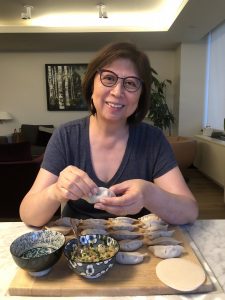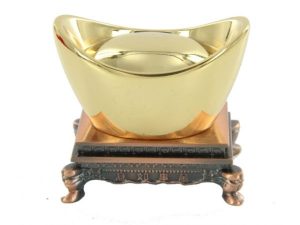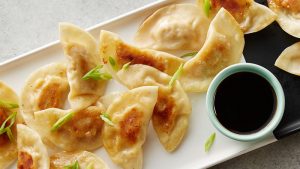Dylan Frank
Guo Tie (er) in Steam
When my mother made jiaozi (dumplings) touched with oil,
She would cover them first in a veil of steam.
With a light touch she would flip each one
Until each side had turned golden.
As they crackled and sizzled the house would know
She watched the jiaozi so they cooked to gold
Then she would say “chi fan chi fan
Kuai dian er lai – Food is getting cold!”
Golden like yuan bao (golden ingots) but crisp like leaves
What took hours to make gone in seconds
Big plates of jiaozi shared with my entire family
When I left that afternoon, I knew I’d be home soon.
*Author’s note: “Chi fan chi fai // Kuai dian er lai” means “eat food eat food, come quickly”.
*Author’s note 2: Yuan bao Golden Ingot: https://www.fengshuiweb.co.uk/history-of-the-yuanbao-wealth-ingot/
1. What piece did you choose to imitate?
I chose to imitate Hong Junju’s “Noodles in Broth” by turning my memories of the potstickers my mother makes into a poem: “Guo Tie (er) in Steam.”
Notes: In Chinese, guo tie means “Potstickers.” Potstickers are pan-fried dumplings crispy on the bottom. The crust is obtained by placing cold dumplings in a very hot pan with a layer of sizzling oil. When the oil begins to smoke, it is then time to add the dumplings to the pan. When the dumplings begin to stick to the pan, they end up developing a crunchy film because of the oil, and small amounts of water can be used strategically to create steam, hence allowing the cook to obtain an even more substantial golden crust.
While steam may not be traditionally associated with making guo tie, this is a trick that my mother uses to make them crispy all the way around. I am not quite sure how widespread this practice is, but the sizzling sound that the water makes as it shifts to vapor always let me know, growing up, that guo tie was in my near future. My mother always holds the pan lid in one hand and a small glass in the other when she adds the water in small amounts to create the golden film around the jiaozi. Thinking about the sizzle of the oil and the sound of the water turning into steam always reminds me of the comfort of home. I have also been unable to successfully replicate this tactic on my own without waterlogging the guo tie (er).
2. Why did you choose this piece?
I chose to imitate “Noodles in Broth” because I appreciated how it managed to take a fairly nuanced cooking and dining experience and artfully represent it to the reader in just 12 lines. In doing so, it managed to present in vivid detail the author’s feelings surrounding the dish while making the reader (in this case, myself) feel that he could be in the moment with the author as Chef Cui prepared his dish.
With “Guo Tie (er) in Steam,” I spoke to the audience about a personal memory and family tradition: Potstickers before farewells. While this meal that inspired this poem happened the day I left for freshman year of Emory, multiple jiaozi dinners similar to this one have been had to commemorate new journeys. I thought that I could best represent this memory by imitating the form and style of Hong Junju’s “Noodles in Broth,” which is why I chose to model my piece after his (as opposed to another author’s).
3. What did you learn about the culture of the original author through imitating his or her style?
While I was trying to imitate Hong Junju’s poem, I realized that his precision with language is extremely noteworthy. Notably, I found it quite difficult to write a poem that fit within the same stylistic guidelines while also conveying the personal meaning I was trying to capture. Even when translated from Chinese to English the beauty of Hong Junju’s writing still remains. In trying to imitate Hong’s “Noodles in Broth,” I also gained a more nuanced understanding of the poem and also a deeper comprehension of the Chinese cultural traditions that were important to Hong. I realized, for example, how he managed to incorporate multiple traditional Chinese themes in his writing. For example, when describing the process of making bing, he used an analogy that equated the noodles with “autumn silk”. This metaphor both spoke to the seasonality inherent in Chinese cuisine as well as traditional Chinese objects like silk. Hong also spoke about the experience of dining from a sensory perspective in the language that he used through descriptions of dining with friends (“We would gulp them down all at once”) and also of how consuming the noodles personally affected him (After two bowls in a row, // A smile would come to the lips, the body would relax). I felt that these lines spoke to the author’s underlying feelings regarding the dining experience in a more subtle way. In writing “Guo Tie (er) in Steam” I also hoped to relay my feelings on the ritual of eating potstickers together as a family before one of us goes on a long journey in an understated way.
4. What did you learn about your own culture while writing?
Writing this poem allowed me to further realize how Chinese food and cultural traditions often go hand-in-hand. For example, the familial aspect of Chinese cuisine: the most elaborate dishes we eat at home are usually consumed as a family. Moreover, in the brainstorming process for “Guo Tie (er) in Steam,” I thought back to some of the class lectures and readings that we had on Chinese food. Furthermore, through writing this poem, I took the time to both outline and analyze the connections between my Chinese culture and my dining experiences in a highly intentional way. This deliberate process of thinking, analyzing, and writing allowed me to produce a poem with both personal meaning and cultural relevance. Thus, through the process of writing this poem, I further realized how cuisine and family are connected in Chinese culture. Additionally, through the process of reflection required of me to write this poem, I also ended up gaining a stronger sense of pride in my Chinese-American identity.
5. Is there cultural DNA embedded in the piece you read and in your piece? How does this DNA manifest in the texts?
Both my piece and Hong Junju’s explored traditional Chinese themes to relay a food preparation and dining experience. In “Noodles in Broth,” Hong incorporated Chinese cultural DNA through descriptors such as “filter the tea infusion through silk” and “In long strings / White like autumn silk.” Hong’s descriptions of “silk” (invented by China, symbolizing luxury, simplicity, and elegance), and “autumn” (which reflects seasonality) are both deeply symbolic within Chinese culture. Lastly, in describing the process of the bing being “steeped in tea,” Hong Junju further relayed cultural DNA to his audience since tea is part of many Chinese meals. For the dish that Hong described, tea was an essential component.
In “Guo Tie (er) in Steam” I embedded cultural DNA through the strategic use of certain language devices. For example, my mother is from Beijing and she often uses the speech particle “er” at the end of certain sentences. The “er” sound, many Chinese joke, is extremely typical of Mandarin speakers from certain parts of Northern China. I therefore decided that I could more fully capture the experience of eating potstickers using the speech particle “er” in my title to more fully capture the experience. Moreover, talking about yuan bao (golden ingots) and using my mother’s universal meal announcement (which is always said in both English and Chinese so that all in my household may understand) further speak to how the experience of eating fried potstickers, for me, relates to my identity as a Chinese-American. Lastly, the attention to detail required to execute the jiaozi on my mother’s part, as well as the emphasis on family when consuming them (i.e. we try to eat jiaozi at the table together as a family of four) further relate back to traditional Chinese cultural symbolism and hence represent cultural DNA within my poem.
Images:




Source:https://www.tablespoon.com/recipes/lemon-chicken-potstickers/31aa0029-d59c-490d-9cc2-e08f36f928f0
